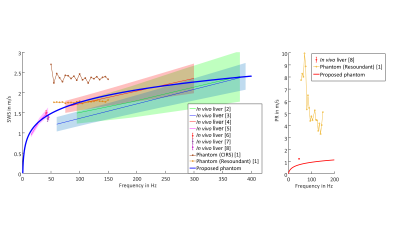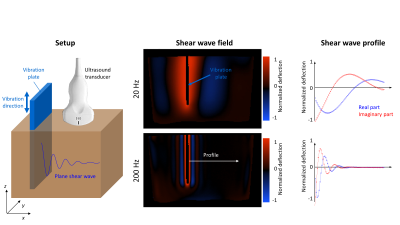Anna Morr1, Helge Herthum1, Felix Schrank1, Steffen Görner1, Jürgen Braun1, Ingolf Sack1, and Heiko Tzschätzsch1
1Charité - Universitätsmedizin Berlin, Berlin, Germany
1Charité - Universitätsmedizin Berlin, Berlin, Germany
The proposed elastography phantom has viscous
and elastic properties in a wide frequency range similar to that of the human
liver. The novel phantom facilitates technical developments and improvements of
MRE and USE.

Comparison of the proposed
phantom with in vivo literature data
and conventional phantoms by means of shear wave speed (SWS) and penetration
rate (PR). The CIRS phantom showed no measurable shear wave damping (due to an
inverse relation between damping and PR, this corresponds to an infinity PR). Therefore,
the PR for CIRS phantom was not shown.

Setup and post
processing for USE and clinical MRE. A vibration plate was inserted in the
phantom to create plane shear waves. Shear wave fields for all vibration
frequencies are acquired within the $$$x-z$$$-plane. After frequency selection
by Fourier transformation a profile was drawn parallel to the wave propagation
(shown wave fields based on MRE). Viscoelastic properties (shear wave speed,
penetration rate) are obtained by fitting profile data (circles) with a damped
complex shear wave (solid lines).
